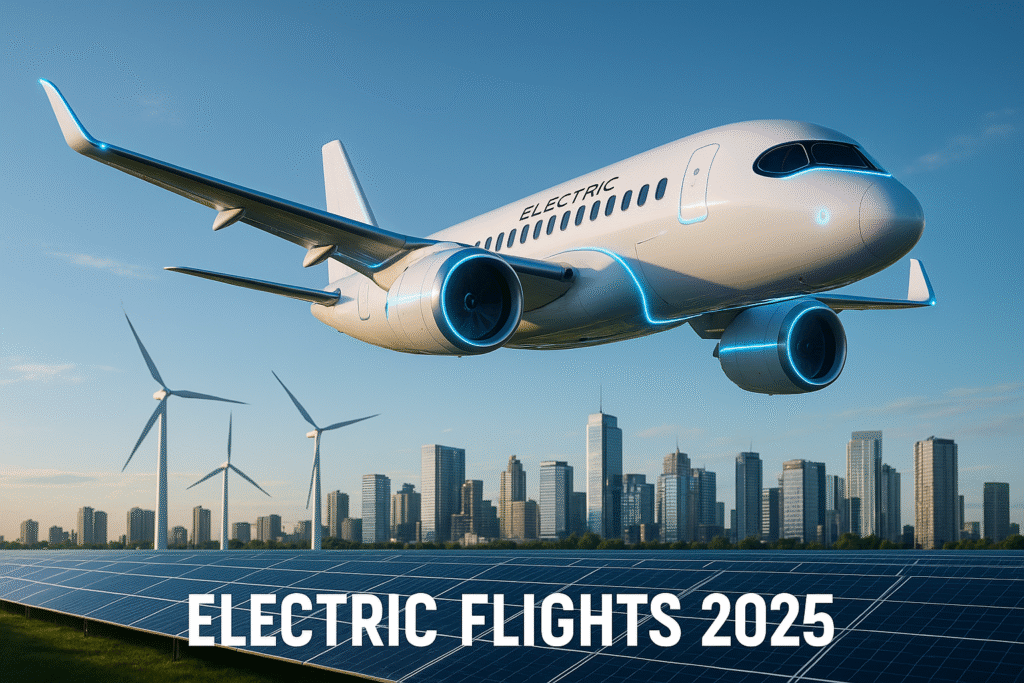Air travel has long been associated with speed and convenience, but also with significant environmental impact. As the world prioritizes sustainability, electric flights are emerging as a revolutionary solution that could reshape the aviation industry. In 2025, electric aircraft are no longer just a concept — they’re moving closer to mainstream adoption, promising cleaner, quieter, and more efficient air travel.
Here’s a look at how electric flights are changing the future of aviation.
1. What Are Electric Flights?
Electric flights use electric propulsion systems powered by batteries or hybrid-electric engines instead of traditional fossil fuels. These aircraft are designed to reduce carbon emissions, noise pollution, and operational costs.
Types of Electric Aircraft:
- Fully Electric: Powered entirely by batteries, ideal for short distances.
- Hybrid-Electric: Combines traditional fuel engines with electric motors for longer flights.
- Solar-Powered Aircraft: Experimental planes using solar panels to generate electricity.
2. Benefits of Electric Flights
Electric aviation offers numerous advantages for the environment, passengers, and airlines:
- Reduced Carbon Emissions: Lower greenhouse gas emissions compared to conventional jets.
- Quieter Operations: Electric motors produce significantly less noise, improving urban airport environments.
- Lower Operating Costs: Fewer moving parts reduce maintenance and fuel expenses.
- Potential for Regional Travel: Short-haul flights could become more affordable and sustainable.
3. Technological Innovations Driving Electric Aviation
Several breakthroughs are making electric flights possible:
- Advanced Battery Technology: High-energy-density batteries allow longer flight ranges.
- Lightweight Materials: Composite and carbon-fiber airframes improve energy efficiency.
- AI-Powered Flight Management: Optimizes energy usage and navigation to maximize range.
- Hybrid Propulsion Systems: Combine the best of electric and traditional engines for efficiency.
4. Challenges to Widespread Adoption
Despite the excitement, electric aviation faces some hurdles:
- Battery Limitations: Current batteries still limit flight range and payload capacity.
- Infrastructure Needs: Airports require charging stations and maintenance facilities.
- Regulatory Approvals: Certification of new electric aircraft is time-consuming and complex.
- Cost Barriers: Initial manufacturing and research costs are high, though decreasing over time.
5. Key Players in Electric Aviation
Several companies and startups are leading the charge in 2025:
- Eviation Alice: Fully electric commuter aircraft designed for regional travel.
- Heart Aerospace: Developing hybrid-electric 19-seater aircraft for short routes.
- Joby Aviation: Focused on electric vertical takeoff and landing (eVTOL) aircraft.
- Wright Electric: Building electric aircraft for commercial flights.
6. Impact on the Future of Travel
Electric flights have the potential to redefine air travel in multiple ways:
- Sustainable Tourism: Eco-conscious travelers can reduce their carbon footprint.
- Urban Air Mobility: eVTOL aircraft may enable faster, low-emission city-to-city travel.
- Affordable Regional Travel: Lower operational costs could reduce ticket prices for short flights.
- Cleaner Skies: Reduced emissions and noise pollution benefit both urban and natural environments.
7. What Travelers Can Expect in 2025 and Beyond
While fully electric commercial flights are still emerging, short-haul regional routes and hybrid-electric aircraft are likely to become more common. Travelers can anticipate:
- Quieter and smoother flights
- Reduced environmental impact per trip
- Innovative aircraft interiors with advanced technology
- Integration of AI for efficient, sustainable travel
Conclusion
Electric flights represent a transformative leap in aviation, combining sustainability, innovation, and efficiency. While challenges remain, 2025 is witnessing the beginning of a new era in air travel where cleaner skies and eco-conscious flying become a reality.
The future of aviation is electric — and every journey taken by these aircraft brings us closer to a greener, smarter world of travel.

